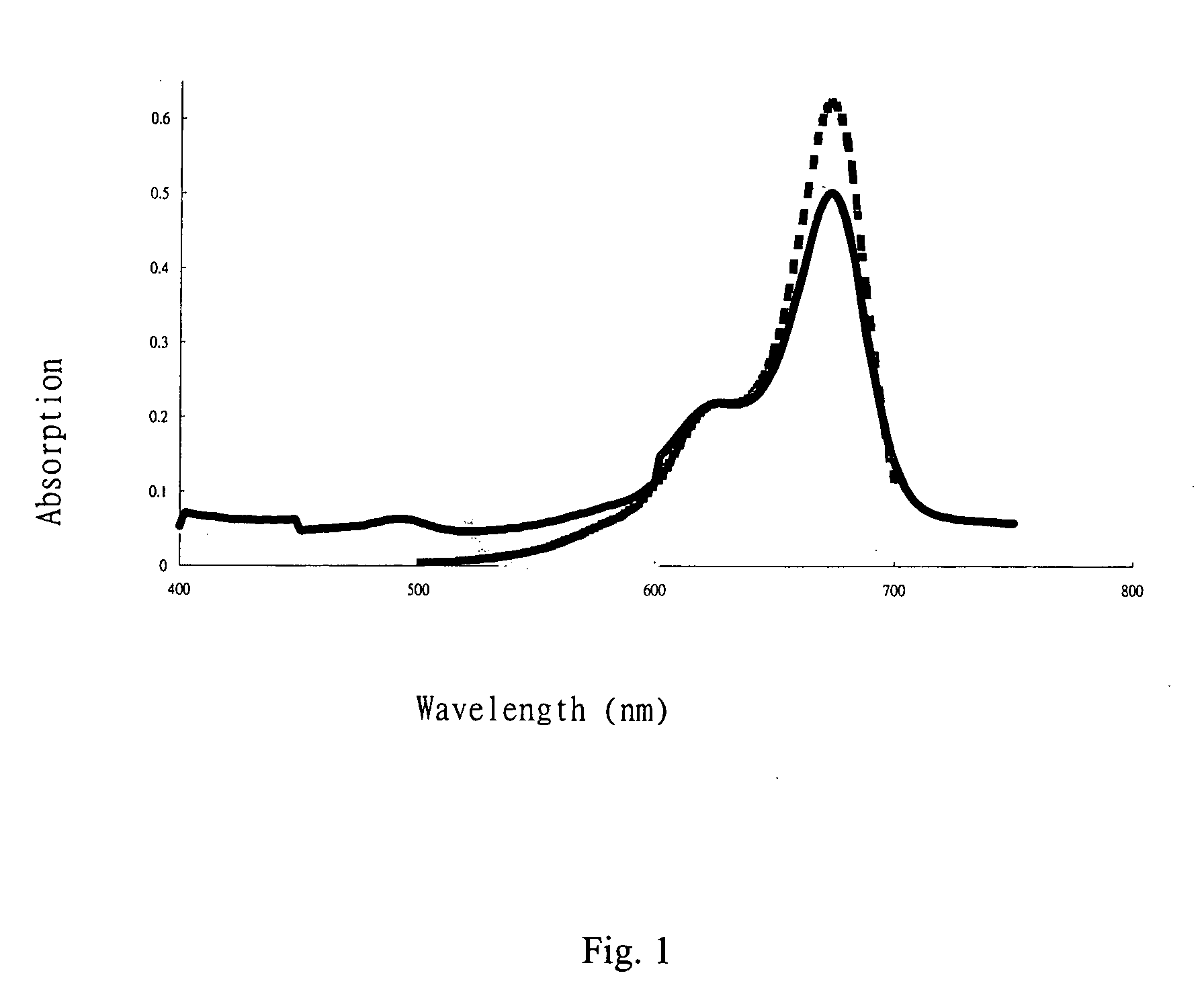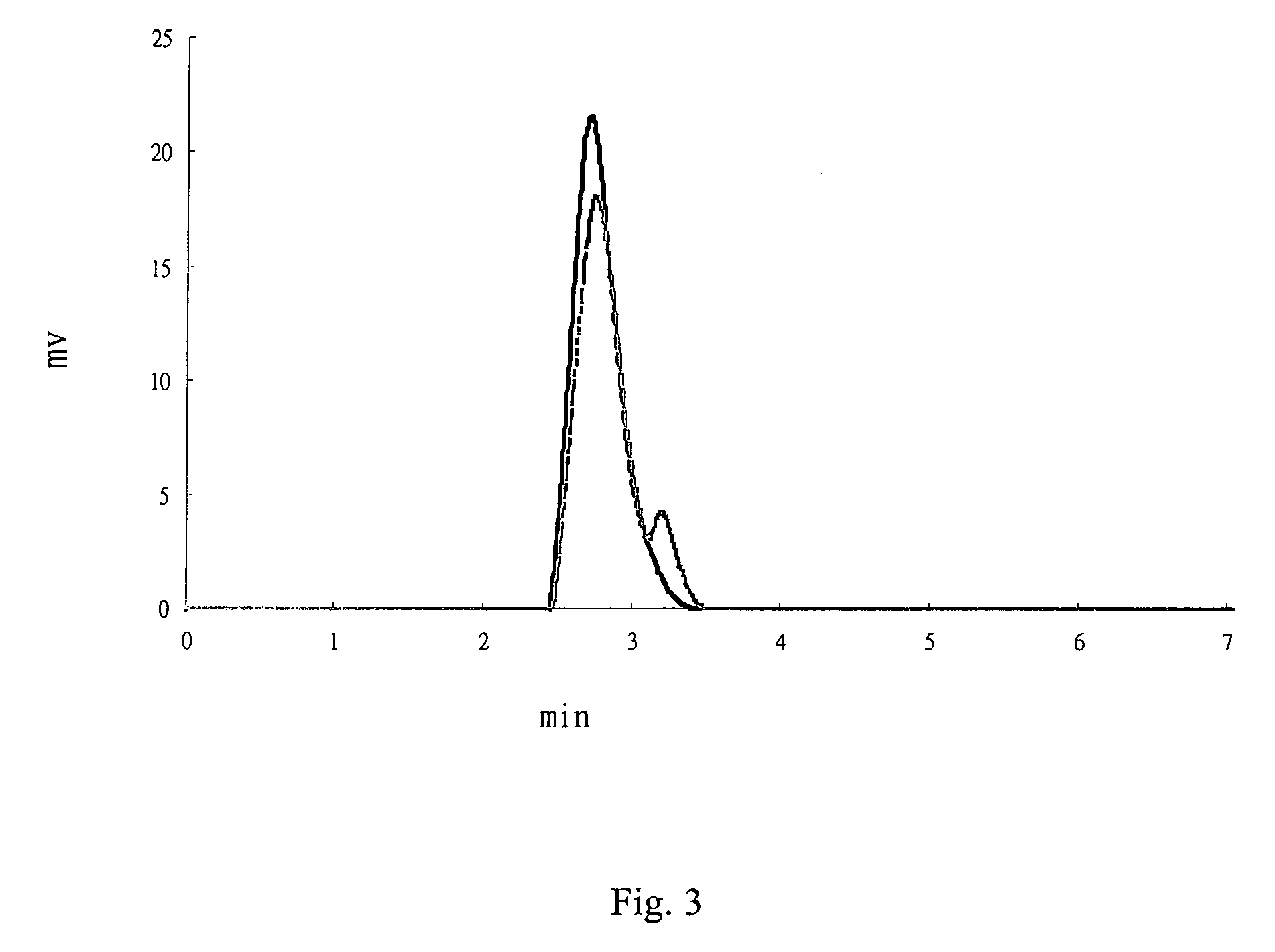Prostate-specific antigen probes for optical imaging
an antigen and prostate technology, applied in the field of prostate-specific antigen probes for optical imaging, can solve the problems of insufficient use of photons in this wavelength range in in-vivo or in-vitro applications
- Summary
- Abstract
- Description
- Claims
- Application Information
AI Technical Summary
Benefits of technology
Problems solved by technology
Method used
Image
Examples
example 1
Preparation of Methoxy Polyethylene Glycol Nitrile (2)
[0068] 25 g (5 mmole) of methoxy polyethylene glycol is dissolved in 25 ml de-ionized water and put into a 250 ml flask. 0.5 g of potassium hydroxide is added into the mixtures in ice-bath (0-5° C.) and 4.3 ml of acetonitrile is slowly added and react for 2.5 hour. Sodium phosphate is added into the solution after reaction to regulate pH value to 7.0. 200 ml, 70 ml and 50 ml of dichloromethane are respectively used to extract it for three times. The organic layer is collected to precipitate out water by magnesium sulfate, filtered to collect liquid and precipitated to elute solid by ethyl ether. After filtration, the solid is vacuum dried to obtain 23.2 g white solid with a yield of 91.8%. 1H-NMR(200 MHz, CDCl3), δ (ppm): 2.1 ppm (t, 4H, —CH2CN), 3.3 ppm (s, —OCH3), 3.5 ppm (s, —CH2CH2O—), 13C NMR (200 MHz, CDCl3), δ (ppm) 28.8, 70.5, 128.2. IR: 2360 cm−1 (—CN).
example 2
Synthesis method of methoxypoly(ethylene glycol) amide (3)
[0069] 23 g (4.6 mmol) of methoxypoly(ethylene glycol)nitrile is dissolved in 111.4 ml of hydrochloric acid and is stirred under vibration at room temperature for 48 hours. After reaction ended, the solution is diluted with 1000 ml de-ionized and extracted with 200 ml, 150 ml and 100 ml of dichloroethane respectively three times. The collected organic layer is washed with de-ionized water twice, eluted out water with sodium sulfate, filtered to obtain filtered solution so as to dry the solution by a reduced-pressure evaporator, and vacuum dried to obtain 20.7 g of product with a yield of 90.1%. 1H-NMR(200 MHz, CDCl3), δ (ppm): 2.47 ppm (t, 4H, —CH2CONH2), 3.2 ppm (s, —OCH3), 3.5 ppm (s, —OCH2CH2O—), IR:3424 cm−1 (—NH2), 1638 cm-−1, (—CONH2).
example 3
Synthesis method of methoxypoly(ethylene glycol) propionic acid (4)
[0070] 16 g (3.2 mmole) of methoxypoly(ethylene glycol)amide is solved into 1000 ml of de-ionized water. At room temperature 100 g (1.79 mole) of potassium hydroxide is added into the resulting solution to react for 22 hours. After reaction, 150 g (1.91 mole) sodium chloride is added. The solution is extracted by 150 ml dichloromethane for three times. The organic layer is collected, washed with 5% oxalic acid and de-ionized water and eluted out water with sodium sulfate. The solution is filtered and precipitated by ethyl ether to obtain solid. The solution is filtered to be vacuum dried to obtain 13.7 g of product with a yield of 85.8%. 1H-NMR(200 MHz, CDCl3), δ (ppm): 2.5 ppm (t, 4H, —CH2COOH), 3.2 ppm (s, —OCH3), 3.5 ppm (s, —OCH2CH2O—), 13C NMR (200 MHz, CDCl3), δ (ppm) 30.7, 39.5, 39.7, 69.8, 206.5. IR: 3453 cm−1 (—OH).
PUM
| Property | Measurement | Unit |
|---|---|---|
| Fluorescence | aaaaa | aaaaa |
Abstract
Description
Claims
Application Information
 Login to View More
Login to View More - R&D
- Intellectual Property
- Life Sciences
- Materials
- Tech Scout
- Unparalleled Data Quality
- Higher Quality Content
- 60% Fewer Hallucinations
Browse by: Latest US Patents, China's latest patents, Technical Efficacy Thesaurus, Application Domain, Technology Topic, Popular Technical Reports.
© 2025 PatSnap. All rights reserved.Legal|Privacy policy|Modern Slavery Act Transparency Statement|Sitemap|About US| Contact US: help@patsnap.com



